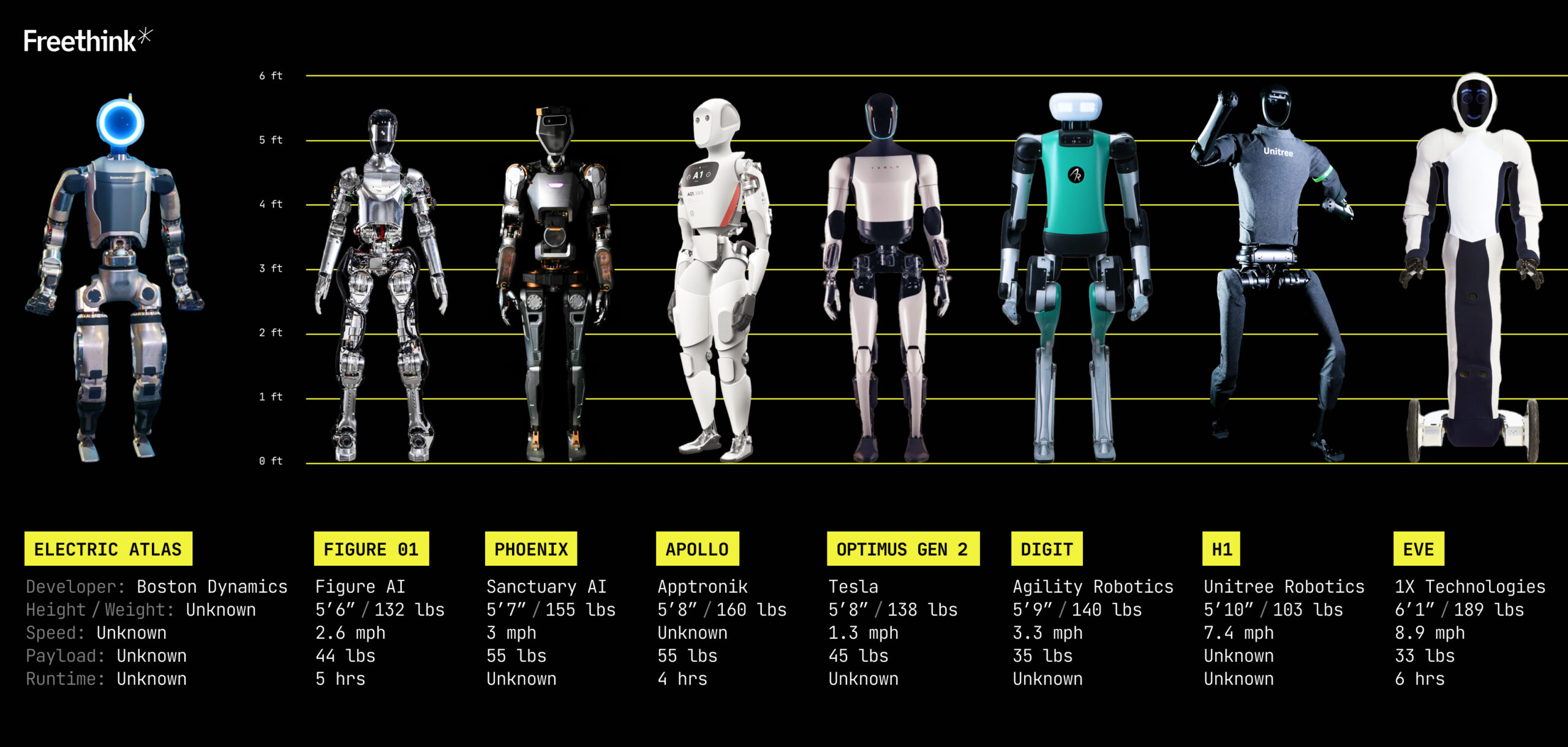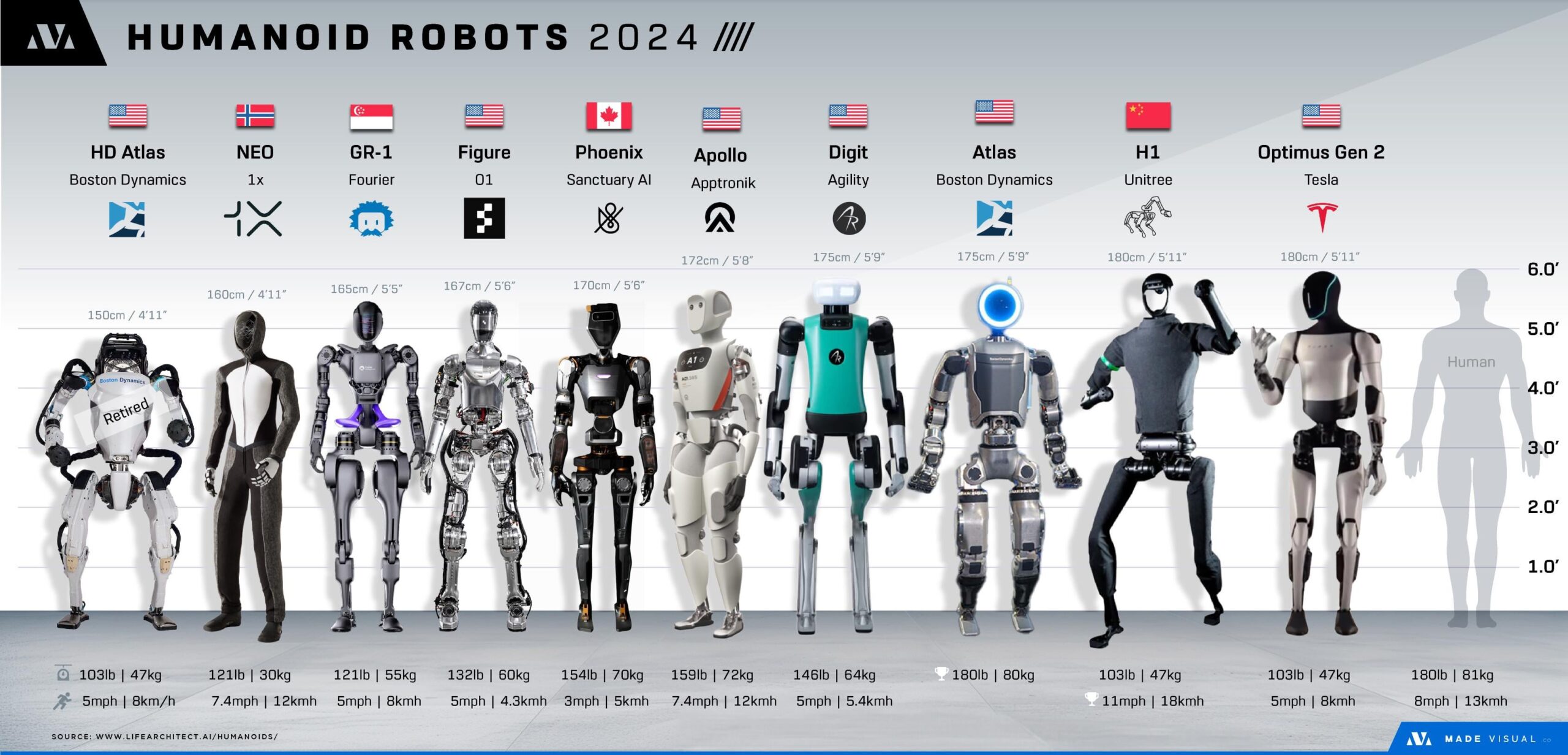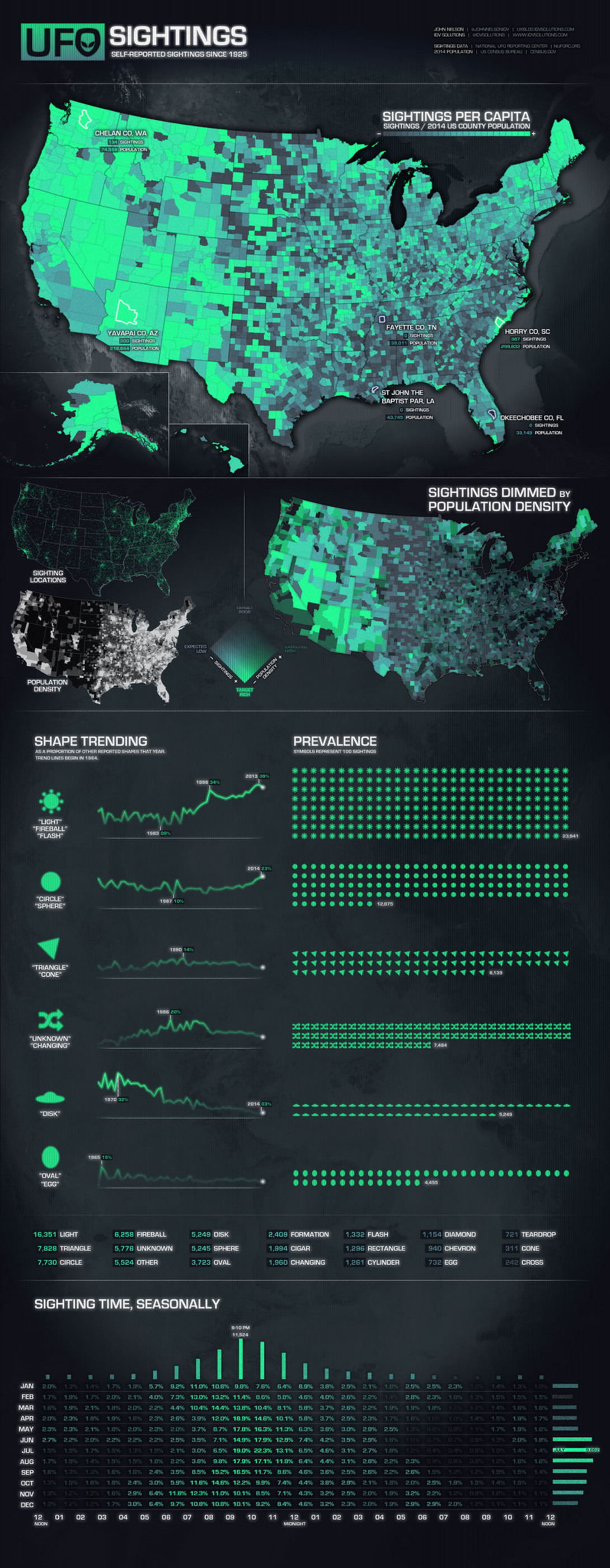Exploring the Robotics Lineup of 2024
In the race to develop the next generation of humanoid robots, companies around the world are making significant strides in design, functionality, and real-world application. The “Humanoid Robots 2024” infographic offers a glimpse into this competitive landscape, showcasing robots from leading tech giants and robotics firms across different countries. Each model, whether designed for agility, strength, or precision, represents a unique approach to bridging the gap between human and machine capabilities. Let’s break down the lineup and see what these robots have to offer.

Analyzing the 2024 Lineup of Humanoid Robots
- HD Atlas – Boston Dynamics (USA)Standing at 150 cm (4’11″) and weighing 47 kg (103 lbs), HD Atlas from Boston Dynamics has been a pioneer in the humanoid robotics field. Known for its agility and balance, HD Atlas can reach speeds of up to 8 km/h (5 mph). However, it has been marked “retired” in this lineup, indicating that Boston Dynamics may have transitioned its focus towards newer models or other robotic forms. Despite this, HD Atlas remains iconic, having paved the way for advanced movement and mobility in humanoid robotics.
- NEO – 1x (Norway)
The NEO robot stands at 160 cm (4’11″) and weighs 30 kg (121 lbs). With a top speed of 12 km/h (7.4 mph), NEO showcases a sleek, minimalist design optimized for lightweight mobility. Its development by Norwegian firm 1x suggests a focus on efficiency and maneuverability. This model may be geared towards tasks requiring quick movement in dynamic environments, such as warehousing or emergency response situations. - GR-1 – Fourier (Singapore)
Singapore’s Fourier presents the GR-1 robot, which is 165 cm (5’5″) tall and weighs 55 kg (121 lbs). With a speed capacity of 8 km/h (5 mph), GR-1’s design suggests an emphasis on agility combined with dexterity. The relatively modest weight and speed balance make it a suitable candidate for interactive and assistive tasks, potentially in healthcare or hospitality. - Figure 01 – Figure (USA)
Standing at 167 cm (5’6″) and weighing 60 kg (132 lbs), Figure 01 has a top speed of 4.3 km/h (2.7 mph). This slower speed indicates that Figure 01 may be tailored for more precise and controlled environments, like factory floors or assembly lines, where accuracy takes precedence over speed. Its robust design and intermediate stature show a focus on performing detailed, repetitive tasks. - Phoenix – Sanctuary AI (Canada)
At 170 cm (5’6″) and weighing 70 kg (154 lbs), Phoenix by Sanctuary AI is designed for stability and strength. With a speed limit of 5 km/h (3 mph), it appears this model prioritizes heavy-duty capabilities over swift movements. Its larger frame may be suitable for applications that involve lifting or moving objects, making it an asset in construction or industrial sectors. - Apollo – Apptronik (USA)
Apollo stands at 172 cm (5’8″) and weighs 72 kg (159 lbs), capable of reaching speeds of up to 12 km/h (7.4 mph). This model combines height and agility, making it ideal for dynamic environments that require both speed and reach. Apptronik’s design suggests Apollo could be effective in logistics or retail settings where movement across large spaces and interaction with varying heights are important. - Digit – Agility Robotics (USA)
The Digit robot from Agility Robotics measures 175 cm (5’9″) and weighs 64 kg (146 lbs). With a speed of 5.4 km/h (3.3 mph), Digit is designed with efficiency and balance in mind. The humanoid frame and modest speed point to applications in environments where precision is needed, such as autonomous delivery or customer assistance roles in stores and facilities. - Atlas – Boston Dynamics (USA)
Boston Dynamics’ newer Atlas model, standing at 175 cm (5’9″) and weighing 80 kg (180 lbs), is known for its athletic capabilities, showcasing impressive mobility with a top speed of 8 km/h (5 mph). Atlas is built to navigate complex terrains, leap over obstacles, and perform a variety of physically demanding tasks, making it suitable for search and rescue missions or work in hazardous environments. - H1 – Unitree (China)
China’s Unitree presents the H1 robot, standing at 180 cm (5’11″) and weighing 47 kg (103 lbs). With a speed capability of 18 km/h (11 mph), H1 demonstrates an impressive balance of height, weight, and speed. This robot’s lightweight frame and agility could be advantageous for scenarios that require swift, responsive movements, such as security patrols or emergency evacuation assistance. - Optimus Gen 2 – Tesla (USA)
Tesla’s Optimus Gen 2 stands as the tallest in the lineup at 180 cm (5’11″) and weighs 81 kg (180 lbs). With a speed of 13 km/h (8 mph), this model embodies Tesla’s vision for advanced humanoid capabilities, likely aimed at integrating AI-driven interactions into a range of everyday activities. From home assistance to factory automation, Optimus Gen 2’s speed and stature suggest versatility in various environments, reflecting Tesla’s ambition to revolutionize human-robot interaction.

What These Robots Mean for the Future
The 2024 lineup of humanoid robots shows a diverse array of designs, each tailored for specific applications. Whether optimized for speed, agility, strength, or precision, these robots are shaping up to play significant roles in various industries:
- Healthcare and Assistance: Models like NEO and Apollo could serve in hospitals or homes, providing care for patients, monitoring health, or assisting with daily tasks.
- Manufacturing and Logistics: Robots such as Phoenix and Figure 01 demonstrate the potential for industrial and logistical work, automating repetitive tasks on factory floors or warehouses.
- Emergency Response: Agile models like Atlas and H1 have the capability to navigate challenging environments, making them suitable for search and rescue missions or disaster response scenarios.
- Retail and Public Spaces: Digit and Optimus Gen 2 could be deployed in stores, airports, or public spaces, offering customer service, wayfinding assistance, or even delivering goods.
The Road Ahead: Humanoids in Our Daily Lives
The diversity in this lineup underscores the growing importance of humanoid robots in our society. Companies like Tesla, Boston Dynamics, and Sanctuary AI are not just experimenting with robotics but are actively pushing the boundaries to bring them into everyday life. The focus is increasingly on making robots capable of operating safely and effectively in human environments, responding to changing demands in real time, and performing tasks that enhance human productivity and quality of life.
However, as these technologies evolve, there will also be challenges regarding integration, safety, and ethics. The ability of robots to interact seamlessly with humans requires advanced programming, rigorous testing, and considerations around privacy and autonomy. As we move forward, collaboration between technology developers, policymakers, and society at large will be crucial to ensure that the integration of humanoid robots remains safe, ethical, and beneficial.
The 2024 humanoid robot lineup is just the beginning. As these robots continue to develop, they promise to reshape industries and daily routines alike. We are witnessing the dawn of a new era—one where the line between human and machine capabilities becomes increasingly intertwined.







